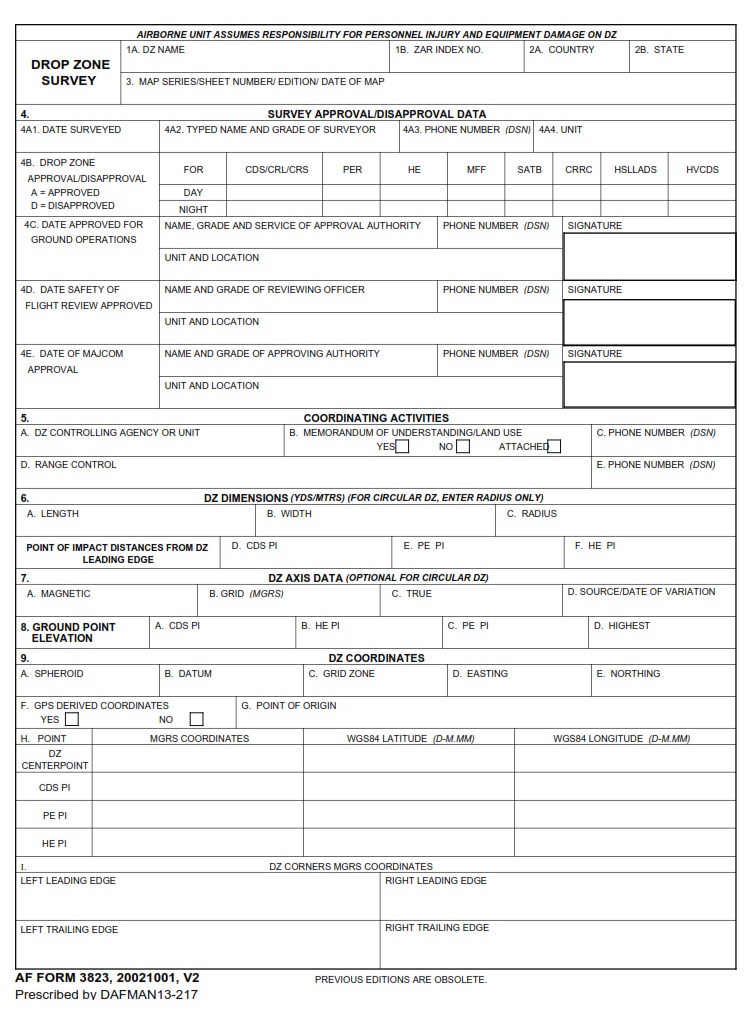AF-FORMS.COM – AF Form 3823 – Drop Zone Survey – Have you ever wondered what goes into preparing a drop zone for military operations? Picture this: a vast expanse of empty land, transformed within minutes into a strategic landing site for airborne troops and supplies. Behind this seamless transformation lies the meticulous planning and execution of an Air Force Form 3823 – Drop Zone Survey. In this article, we’ll uncover the secrets behind these covert surveys and delve into the crucial role they play in ensuring successful airborne operations. So buckle up, because we’re about to take you on an adrenaline-pumping journey through the world of drop zone surveys.
Imagine standing at the edge of a field, anticipation coursing through your veins as you watch parachutes dotting the sky above. How did that seemingly ordinary patch of land transform into a staging ground for high-stakes military maneuvers? Enter AF Form 3823 – Drop Zone Survey, the unsung hero behind every successful aerial operation. In this article, we’ll lift the veil on these behind-the-scenes surveys and explore their critical importance in guaranteeing precision and safety in airborne missions. Get ready to uncover what it takes to transform an ordinary piece of Earth into an extraordinary launching pad for our nation’s elite forces.
Download AF Form 3823 – Drop Zone Survey
| Form Number | AF Form 3823 |
| Form Title | Drop Zone Survey |
| Edition Date | 10/1/2002 |
| File Size | 41 KB |
AF-Form-3823-Drop-Zone-Survey.pdf (66 downloads )
What is an AF Form 3823?
The AF Form 3823 is a crucial document used by the United States Air Force to conduct drop zone surveys. This form provides vital information to ensure the safety and effectiveness of military airborne operations. It serves as a tool for documenting and assessing the suitability of potential drop zones for parachutists, equipment, and aircraft involved in specialized training or combat scenarios.
One key aspect of the AF Form 3823 is its ability to capture detailed data on drop zone conditions. This includes factors such as terrain features, ground obstacles, obstructions near or within the drop zone, weather conditions, and availability of emergency services. By gathering this information beforehand, military planners can make informed decisions about whether or not a particular location meets the necessary criteria for safe parachute operations.
Another important function of the AF Form 3823 is its role in facilitating coordination between different units involved in airborne operations. The form helps streamline communication by serving as a standardized means of sharing vital information among various stakeholders: from pilots and aircrews to ground personnel responsible for prepping paratroopers or cargo drops. Its structured format ensures that all parties have access to up-to-date details relevant to their respective roles, ultimately contributing to smoother and more efficient mission execution.
In summary, while it may seem like just another document in bureaucratic procedures at first glance, the AF Form 3823 plays a pivotal role in ensuring safe and successful airborne operations for the U.S. Air Force personnel around the world.
Where Can I Find an AF Form 3823?
If you are wondering where to find an AF Form 3823, look no further! The Air Force Form 3823, also known as the Drop Zone Survey, plays a crucial role in ensuring the safety and efficiency of parachute operations. Before diving into where to locate this essential form, let’s briefly explore its purpose. The AF Form 3823 is used to document survey information about potential drop zones, including factors such as obstacles, wind patterns, and feasibility for airborne operations.
To obtain an AF Form 3823, your first point of contact should be your unit’s administrative office or airfield management. They will likely have a supply section that maintains a stock of these forms. Furthermore, if your unit has its own dedicated Safety Office or Parachute Program Manager, they can provide you with the necessary guidance on how to acquire the form. In some cases, digital versions may be available on official Air Force websites or specialized databases accessible to authorized personnel.
Remember that when it comes to obtaining an AF Form 3823 for drop zone surveys, communication is key. Reach out to the appropriate channels within your command structure or base agencies devoted to safety and parachuting activities. By doing so, you will ensure that you have all the resources needed to conduct a thorough analysis of any planned parachute operations in accordance with established guidelines and regulations.
AF Form 3823 – Drop Zone Survey
The AF Form 3823, also known as the Drop Zone Survey, plays a crucial role in ensuring safe and effective military operations. This form is used to assess and document the suitability of areas for parachute drops and airdrops. It serves as a valuable tool for planners, mission commanders, and safety officers to make informed decisions regarding drop zone selection.
One interesting aspect of the AF Form 3823 is its emphasis on environmental considerations. When evaluating potential drop zones, survey teams must take into account factors such as obstructions, terrain conditions, noise levels, wildlife habitats, and even cultural resources. This holistic approach ensures that both the mission objectives are met while minimizing negative impacts on local ecosystems.
Another significant aspect of the AF Form 3823 is its collaborative nature. Drop zone surveys require close coordination between different units and stakeholders involved in planning and executing an airborne operation. By involving all relevant parties early in the decision-making process through this form’s completion, potential issues can be addressed proactively. The information gathered from these surveys helps ensure seamless integration between ground forces and airborne assets while maintaining safety standards throughout military operations.
In essence, the AF Form 3823 enables meticulous evaluation of potential drop zones to maximize operational efficiency while mitigating risks associated with parachute drops and airdrops. Its comprehensive assessment criteria encompass not only military requirements but also environmental factors that contribute to sustainable practices during training or combat missions.

